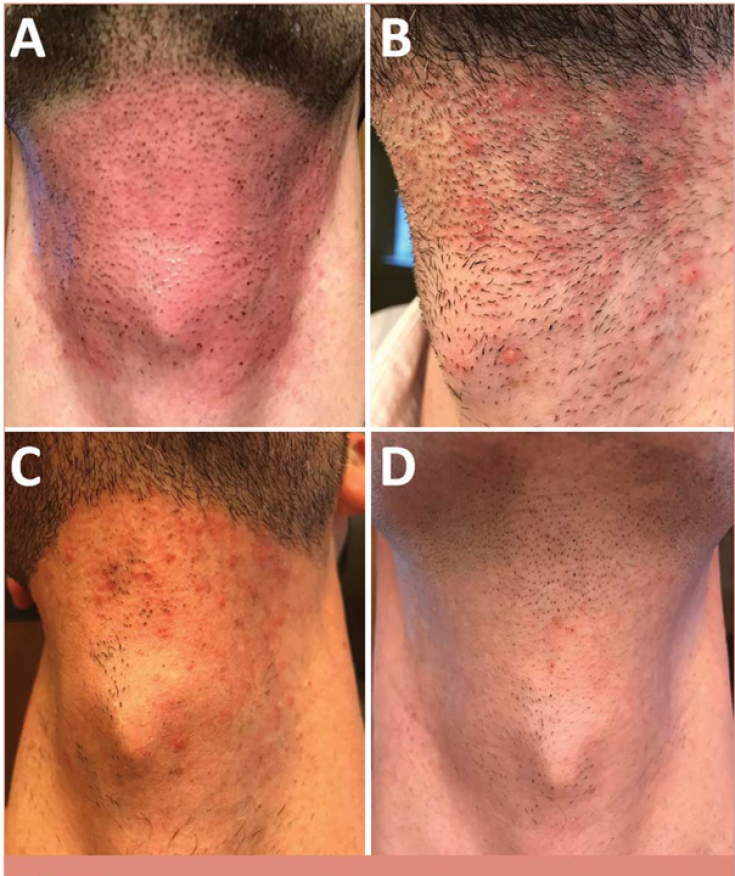Laser hair removal – a popular procedure for which neodymium yttrium aluminum garnet (Nd:YAG) lasers are widely used, especially when working with dark skin types. As a rule, patients tolerate laser therapy well, without serious complications. But in some cases, the development of post-procedural folliculitis is possible, which reduces the degree of satisfaction of patients and gives them psychological and physical discomfort.
In estet-portal.com, Dr. Andrew Schuler, Jesse Veenstra and Alison Tisack present a case of folliculitis after laser hair removal and also review strategies xxxx>treatment and prevention complications.
- Case presentation: folliculitis after laser hair removal
- Discussion of the problem: causes, prevention and treatment of folliculitis after laser hair removal
Case Presentation: Folliculitis after Laser Hair Removal
A patient, 33 years old (Fitzpatrick skin type II, dark and coarse facial hair, multiple pili multigemini) booked in for a laser hair removal procedure.
The procedure was performed with laser Nd:YAG with settings:
- energy 40 J/cm;
- pulse duration 20 ms;
- spot size 10 mm.
The effect was noticeable after the first treatment: a small amount of hair was removed, diffuse erythema and moderate swelling appeared on the treated area, which resolved after 48 hours.
Follow us on Instagram!
Over the next 5-7 days, the patient reported multiple erythematous papules and pustules at the treated area, which slowly resolved over the next 2-4 weeks. The formation was localized mainly around the retained hair shafts and spontaneously resolved as the hair fell out or was removed with tweezers.
The second session of laser hair removal was performed on the patient 6 months later on the same area, with the same laser settings. After the session ended, diffuse erythema and moderate swelling appeared on the treated area without burning sensation and blisters, as in the first time.
To to prevent folliculitis, the patient was prescribed fluocinonide 0.05% cream, to be applied twice daily to the treated area.
However, 6-9 days after laser hair removal, erythematous papules and pustules formed on the treated area.
The patient was prescribed treatment according to the scheme:
- three weeks of doxycycline (100mg daily) starting on day 10 post-procedure;
- gentle washing of affected areas followed by application of fluocinonide cream.
Within a week of topical steroids, doxycycline and gentle washing, the papules and pustules were reduced in severity, and after the course of treatment, the skin was completely cleared of formations.

Photo 1: folliculitis after laser hair removal – A) the treated area immediately after the procedure; C) 9 days after the procedure; C) 15 days after the procedure and 5 days after the start of doxycycline; D) 3 months after the procedure – full resolution.
A third laser hair removal session was performed 4 months later using the same laser settings.
The day before the procedure, the patient was prescribed a 2-week course of treatment for prevention purposes:
- fluocinonide cream twice a day;
- 100 mg doxycycline daily.
Despite preventive therapy, 6-9 days after hair removal, papules formed on the treated skin area. However, their size and number were less than after the first two sessions, as was the intensity of itching.
Read also: Clinical case: perifolliculitis after mesotherapy
The inflamed masses spontaneously resolved after the loss of the central hair shafts. For subsequent sessions, the authors applied the selected folliculitis control strategy .
Discussion of the problem: causes, prevention and treatment of folliculitis after laser hair removal
During laser hair removal, the destruction of the follicle occurs due to photothermolysis. After some time, the remaining hair shaft is removed from the skin, after which the resolution of the folliculitis is observed.
It is assumed that in the described case, the development of folliculitis after exposure to the Nd:YAG laser is due to the stiffness of the patient's hair and the presence of pili multigemini – growth of several hairs from one follicle.
You may also be interested in: Alopecia areata: fractional laser therapy and topical corticosteroids
Prophylactic therapy with topical steroids and oral doxycycline may be warranted in patients with:
- ; history of folliculitis after shaving.
- In this case, flucinonide cream and doxycycline combined with a gentle wash significantly reduced the severity and duration of folliculitis.
Pili multigemini and folliculitis after shaving may be indications for prophylactic treatment of folliculitis after laser hair removal.
In some cases, folliculitis after laser hair removal cannot be prevented, but symptoms can be reduced by the anti-inflammatory effect of steroids and doxycycline, as well as gentle washing, which stimulates hair loss.
Adapted from
J Clin Aesthet Dermatol.
More interesting videos on our





